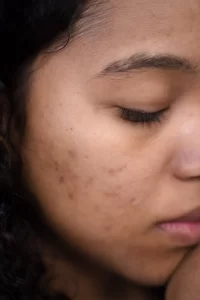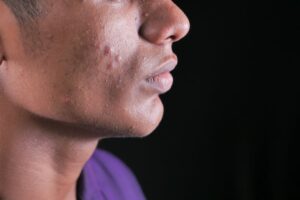Acne On Cheeks: What Causes It And How To Treat It
While breakouts on certain parts of your face can be directly attributed to stress or hormonal imbalances—which means their treatment plan is often a bit more straightforward—acne on your cheeks can be a bit more challenging to figure out since your cheeks come into contact with so many things every day (like your phone, makeup, hair, pillowcases, etc.). Cheek breakouts are definitely possible to treat, especially when you figure out their exact cause.
What does cheek acne look like?
the cheeks are usually prone to inflammatory papules, pustules, nodules, and cystic acne. The red, angry, and notoriously difficult-to-get-rid-of lesions are the ones that most commonly affect the cheeks.

What causes cheek acne?
Cheek acne is typically caused by oil that gets trapped within pores, allowing acne-causing bacteria to grow to higher-than-normal levels and create inflammation in the skin. This buildup of oil can occur for many reasons, from using the wrong skincare products in your routine to fluctuating hormones (yep, hormonal acne on your cheeks is a very real thing) and even daily habits that you may not even realize are impacting your skin.
Acne on the cheeks can be triggered by touching your face or resting your face in your hands, pressing your dirty phone up against your cheek, not changing your pillowcase frequently enough, or friction caused by wearing a protective face covering. Even using a dirty makeup brush or waiting to wash your face after a workout can lead to cheek acne.
How do you get rid of acne on your cheeks?
The most affordable and accessible is using at-home skincare with topical ingredients designed to fight acne. For angry pimples, your go-to ingredient is benzoyl peroxide. It lowers levels of acne-causing bacteria on the skin and helps unclog pores too.
You can find benzoyl peroxide in everything from acne-fighting face washes to acne spot treatments. It’s available in a range of concentrations, though most derms recommend starting with 2.5 percent and then working your way up to a higher percentage since benzoyl peroxide can be quite drying on the skin.

Salicylic acid is another ingredient that’s highly effective at treating cheek acne thanks to its ability to exfoliate dead skin cells and dissolve excess oil in pores. A salicylic acid cleanser goes a long way in helping to break up sebum and debris in the pores. But you can also find salicylic acid in a slew of leave-on treatments, from acne serums to exfoliating toners, so it’s super easy to incorporate into your existing routine.
Beyond benzoyl peroxide and salicylic acid, over-the-counter retinol and retinoids for acne are excellent at treating cheek acne. They work on a cellular level to help kickstart your cell turnover rate, reduce inflammation, and decrease oil production—all key functions for keeping pores clear and skin free of breakouts. Another great option? Hydrocolloid pimple patches. They can be helpful in speeding up the healing of an acne lesion and keeping hands off to reduce the urge to pick at acne lesions.
NOTE
Acne is one of of the trickiest skin issues to deal with, but that’s especially true for breakouts on the cheeks. These angry papules, pustules, cysts, and more can be the result of hormonal or genetic factors, but they can also be triggered by lifestyle habits, like frequently touching your face or not washing your pillowcase enough.
Check www.rknatur.com for more other insights on men, women, skincare, fashion, and health and wellness. For any other inquiries, kindly contact us at +254711519440. Follow youtube.com/c/Ruthkwamby and subscribe for more videos.




